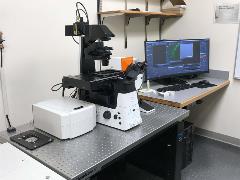Confocal Laser Microscopy
 The Nikon A1R-ER is a point-scanning confocal that contains a dual scanning system built into the scan head. It has both a high resolution galvanometer scanner and a high speed resonance scanner. The galvanometer scanner scans a single illumination point over the image field as fast as 8 frames/sec for a 512 x 512 pixel field and can be used to acquire high spatial resolution images at up to 4096 x 4096 pixels. The resonance scanner can be used to acquire highly temporarily resolved images at up to 15 frames/sec at 1024 x 1024 pixels resolution or 420 frames/sec in band scan acquisition mode at 512 x 32 pixels resolution. A deconvolution module provides for Enhanced Resolution of acquired images. Signal is detected with 2 GaAsP and 2 high sensitivity PMTs for visible lasers, emission sets for 450/50, 525/50, 600/50 (UV/GFP/RFP/Cy5) and the system is set on an inverted Ti2 stage with Perfect Focus System (PFS4) allowing for live cell work. The Ti2 is an exceptionally stable, drift-free platform with hardware-triggering capabilities and high-speed imaging applications allowing quick complete slide scanning. This confocal is driven by the NIS-Elements software platform.
The Nikon A1R-ER is a point-scanning confocal that contains a dual scanning system built into the scan head. It has both a high resolution galvanometer scanner and a high speed resonance scanner. The galvanometer scanner scans a single illumination point over the image field as fast as 8 frames/sec for a 512 x 512 pixel field and can be used to acquire high spatial resolution images at up to 4096 x 4096 pixels. The resonance scanner can be used to acquire highly temporarily resolved images at up to 15 frames/sec at 1024 x 1024 pixels resolution or 420 frames/sec in band scan acquisition mode at 512 x 32 pixels resolution. A deconvolution module provides for Enhanced Resolution of acquired images. Signal is detected with 2 GaAsP and 2 high sensitivity PMTs for visible lasers, emission sets for 450/50, 525/50, 600/50 (UV/GFP/RFP/Cy5) and the system is set on an inverted Ti2 stage with Perfect Focus System (PFS4) allowing for live cell work. The Ti2 is an exceptionally stable, drift-free platform with hardware-triggering capabilities and high-speed imaging applications allowing quick complete slide scanning. This confocal is driven by the NIS-Elements software platform.
Other System Components:
•LUNV laser launch with 405nm, 445nm, 488nm, 514nm, 561nm, 633nm solid state diode lasers (all 20mW output at the fiber tip)
•Hybrid resonant and Galvano scanhead for simultaneous FRAP, photostimulation and optogenetics
•Ti2 Inverted Microscope with 25mm FOV and the Perfect Focus System 4
•Live-cell chamber – stage-top incubator for CO2, temperature and humidity control
•10x, 20x, LWD 40x oil and 60x oil Objectives
•Epifluorescence components